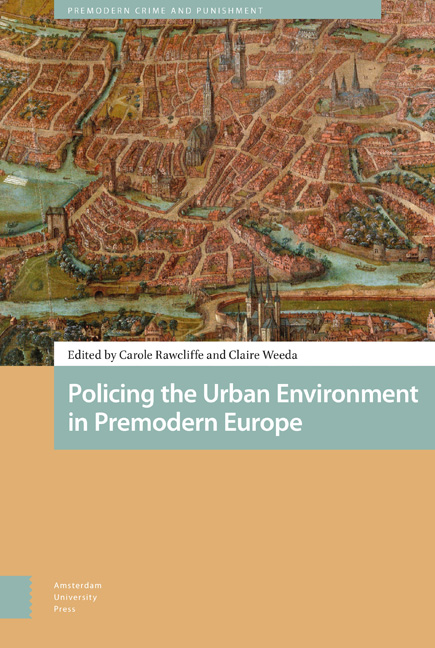Book contents
- Frontmatter
- Contents
- List of Illustrations
- List of Figures and Charts
- Introduction
- 1 Cleanliness, Civility, and the City in Medieval Ideals and Scripts
- 2 The View from the Streets: The Records of Hundred and Leet Courts as a Source for Sanitary Policing in Late Medieval English Towns
- 3 Urban Viarii and the Prosecution of Public Health Offenders in Late Medieval Italy
- 4 Food Offenders: Public Health and the Marketplace in the Late Medieval Low Countries
- 5 Policing the Environment of Late Medieval Dordrecht
- 6 Muddy Waters in Medieval Montpellier
- 7 Regulating Water Sources in the Towns and Cities of Late Medieval Normandy
- 8 Policing the Environment in Premodern Imperial Cities and Towns: A Preliminary Approach
- 9 Official Objectives of theVisitatio Leprosorum: Ambiguity, Ambivalence, and Variance
- Index
9 - Official Objectives of theVisitatio Leprosorum: Ambiguity, Ambivalence, and Variance
Published online by Cambridge University Press: 21 November 2020
- Frontmatter
- Contents
- List of Illustrations
- List of Figures and Charts
- Introduction
- 1 Cleanliness, Civility, and the City in Medieval Ideals and Scripts
- 2 The View from the Streets: The Records of Hundred and Leet Courts as a Source for Sanitary Policing in Late Medieval English Towns
- 3 Urban Viarii and the Prosecution of Public Health Offenders in Late Medieval Italy
- 4 Food Offenders: Public Health and the Marketplace in the Late Medieval Low Countries
- 5 Policing the Environment of Late Medieval Dordrecht
- 6 Muddy Waters in Medieval Montpellier
- 7 Regulating Water Sources in the Towns and Cities of Late Medieval Normandy
- 8 Policing the Environment in Premodern Imperial Cities and Towns: A Preliminary Approach
- 9 Official Objectives of theVisitatio Leprosorum: Ambiguity, Ambivalence, and Variance
- Index
Summary
Abstract
Until the eighteenth century, authorities regularly responded to reports of leprosy by ordering a formal examination, resulting in a certified judgment on the health and future of the suspect. This chapter is part of an ongoing project involving the collation of 600 certificates, recorded between 1250 and 1807, and preserved in Western European archives, set in the wider context of urban regulations, institutional statutes, and royal or imperial edicts. Contrary to prevailing stereotypes, public responses to leprosy varied quantitatively, qualitatively, regionally, and chronologically. A wide range of dynamics beyond the issue of contagion, which monopolizes retrospective discussions of Hansen's disease, is apparent. Public order was more often the paramount concern of examiners, while separation did not necessarily equate with exclusion.
Key words: contagion; diagnosis; leprosy; hospital; sequestration; poverty
Recent epidemics, from H1N1 to Ebola, have intensified, in popular perception and scientific reflection, the awareness of spreading disease. In historical studies, the awareness is contributing to a more focussed interest in the processes and agents of transmission. The tightening preoccupation with physical or ‘objective’ aspects of epidemics may cause a blurring of the context, while human causes and effects are relegated to a distant periphery. In addition, the narrower focus leads some historians to the anachronism of reading modern precision into earlier mentions of contagion, and others to the ahistorical assumption that public health is the immediate or sole objective of any official measure in epidemics. These tendencies, while most evident in the vibrant discourse on bubonic plague, also shape views on the history of Hansen's disease. Views on the early impact of leprosy on society, moreover, reflect the fashionable fascination with medieval ‘marginality’ when they place a one-sided emphasis on the exclusion of lepers and on their treatment as a group. A general aim of this essay is to broaden the understanding of communal responses to leprosy, at least of those that left an imprint in urban records. The more precise aim is to illuminate dimensions of ‘sanitary policing’ beyond the obvious issues of health, contagion, and sequestration.
Visitatio leprosorum
Official records of examinations and their outcomes concretely document the complex diversity in the treatment of lepers by society.
- Type
- Chapter
- Information
- Policing the Urban Environment in Premodern Europe , pp. 271 - 312Publisher: Amsterdam University PressPrint publication year: 2019

